Silla
Silla (57 BC[note 1] – 935 AD) (Korean: 신라; Hanja: 新羅; RR: Silla Korean pronunciation: [ɕil.la]) was a kingdom located on the southern and central parts of the Korean Peninsula. Silla, along with Baekje and Goguryeo, formed the Three Kingdoms of Korea.
Silla 신라 (新羅) | |||||||||||
|---|---|---|---|---|---|---|---|---|---|---|---|
| 57 BC – 935 AD | |||||||||||
 Royal seal
| |||||||||||
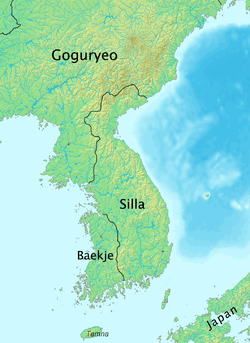 Pre-Later Silla at its height in 576 | |||||||||||
| Capital | Gyeongju (Geumseong, then Seorabeol) | ||||||||||
| Common languages | Old Korean Classical Chinese[1] | ||||||||||
| Religion | Buddhism, Confucianism, Taoism, Shamanism (Sindo) | ||||||||||
| Government | Monarchy | ||||||||||
| King | |||||||||||
• 57 BCE – 4 | Hyeokgeose (first) | ||||||||||
• 540–576 | Jinheung | ||||||||||
• 654–661 | Muyeol | ||||||||||
• 661–681 | Munmu | ||||||||||
• 681–692 | Sinmun | ||||||||||
• 927–935 | Gyeongsun (last) | ||||||||||
| History | |||||||||||
• Establishment | 57 BC | ||||||||||
• Introduction of Buddhism | 530 | ||||||||||
• Campaigns of King Jinheung | 551–585 | ||||||||||
• Silla-Tang War | 668-676 | ||||||||||
| 668–935 | |||||||||||
• Handover to the Goryeo | 935 AD | ||||||||||
| Population | |||||||||||
• 7th century[2] | 894,680 | ||||||||||
• 8th century[2] | 2,000,000 | ||||||||||
| |||||||||||
| Today part of | South Korea North Korea | ||||||||||
| Silla | |
| Hunminjeongeum | |
|---|---|
| Hanja | |
| Revised Romanization | Silla |
| McCune–Reischauer | Silla |
Founded by Hyeokgeose of Silla, of the Park family, the Korean[3] dynasty was ruled by the Gyeongju Gim (Kim) (김, 金) clan for 586 years, the Miryang Bak (Park) (박, 朴) clan for 232 years and the Wolseong Seok (석, 昔) clan for 172 years. It began as a chiefdom in the Samhan confederacies, once allied with Sui China and then Tang China, until it eventually conquered the other two kingdoms, Baekje in 660 and Goguryeo in 668. Thereafter, Later Silla occupied most of the Korean Peninsula, while the northern part re-emerged as Balhae, a successor-state of Goguryeo. After nearly 1,000 years of rule, Silla fragmented into the brief Later Three Kingdoms of Silla, Later Baekje, and Taebong, handing over power to Goryeo in 935.[4]
Name
Until its founding as a full-fledged kingdom, Silla was recorded using several hanja combinations to phonetically approximate its native Korean name. Among those used, there include 斯盧 (사로, Saro), 斯羅 (사라, Sara), 徐那(伐) (서나[벌], Seona[beol]), 徐耶(伐) (서야[벌], Seoya[beol]), 徐羅(伐) (서라[벌], Seora[beol]), and 徐伐 (서벌, Seobeol).
In 504, Jijeung of Silla standardized the characters into 新羅 (신라), which in Modern Korean is pronounced "Silla".
One etymological hypothesis suggests that the name Seorabeol might have been the origin of the word Seoul, meaning "capital city", and also the name of the present capital of South Korea, which was previously known as Hansung or Hanyang. The name of the Silla capital may have changed into its Late Middle Korean form Syeobeul (셔블), meaning "royal capital city," which might have changed to Syeoul (셔울) soon after, and finally resulted in Seoul (서울) in the Modern Korean language.
The name of either Silla or its capital Seorabeol was widely used throughout Northeast Asia as the ethnonym for the people of Silla, appearing as Shiragi in Japanese and as Solgo or Solho in the language of the medieval Jurchens and their later descendants, the Manchus, respectively. In the modern Mongolian language, Korea and Koreans are still known as Солонгос (Solongos), which seems to be an alteration of Silla influenced by the Mongolian word for "rainbow" (солонго solongo).
Silla was also referred to as Gyerim (鷄林, 계림), literally "chicken forest," a name that has its origins in the forest near the Silla capital. Legend has it that the state's founder was born in the same forest, hatched from the egg of a cockatrice (Kor. gyeryong, 雞龍, 계룡, literally "chicken-dragon").
History
Part of a series on the |
||||||||
|---|---|---|---|---|---|---|---|---|
| History of Korea | ||||||||
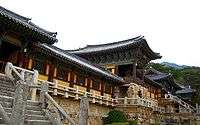 | ||||||||
| Prehistoric period | ||||||||
| Ancient period | ||||||||
|
||||||||
| Proto–Three Kingdoms period | ||||||||
| Three Kingdoms period | ||||||||
|
||||||||
| Northern and Southern States period | ||||||||
|
||||||||
| Later Three Kingdoms period | ||||||||
|
||||||||
| Dynastic period | ||||||||
|
||||||||
| Colonial period | ||||||||
|
||||||||
| Modern period | ||||||||
|
||||||||
| Topics | ||||||||
| Timeline | ||||||||
Founding
During the Proto–Three Kingdoms period, central and southern Korea consisted of three confederacies called the Samhan. Silla began as Saro-guk, a statelet within the 12-member confederacy known as Jinhan. Saro-guk consisted of six villages and six clans.
According to Korean records, Silla was founded by Bak Hyeokgeose of Silla in 57 BC, around present-day Gyeongju. Hyeokgeose is said to have been hatched from an egg laid from a white horse, and when he turned 13, six clans submitted to him as king and established Saro-guk (also called Seona). He is also the progenitor of the Bak (박) clan, now one of the most common family names in Korea.
The Samguk Sagi and History of the Northern Dynasties state that the original Lelang Commandery which later became the Jinhan confederacy (辰韓) was the origin of Silla.[5][6][7] Although archaeological evidence is lacking, the people claimed they were descendants of Qin dynasty (秦, also pronounced as "Jin" in Korean) migrants who, fleeing Qin's forced labour policies, moved to the Mahan confederacy, which gave them land to the east.[8][9][5][6][7][10][11][12]
In various inscriptions on monuments on the 13th king Munmu of Silla, it is recorded that King Munmu possibly has partial Xiongnu ancestry, via the Han dynasty general Jin Midi.[13][14][15] According to several historians, it is possible that this unknown tribe was originally of Koreanic origin and joined the Xiongnu confederation. Later the tribes ruling family returned to Korea and married into the royal family of Silla. There are also some Korean researchers that point out that the grave goods of Silla and of the eastern Xiongnu are alike.[13][14][15][16][17] Some Korean researchers point out that the grave goods of Silla and Xiongnu are alike, and some researchers insist that the Silla king is descended from Xiongnu.[18][19][13][14][20][15] The Korean public broadcaster KBS has produced a documentary about this subject.[21][22][23]
Early period
By the 2nd century, Silla existed as a distinct state in the southeastern area of the Korean peninsula. It expanded its influence over neighboring Jinhan chiefdoms, but through the 3rd century was probably no more than the strongest city-state in a loose federation.
To the west, Baekje had centralized into a kingdom by about 250, overtaking the Mahan confederacy. To the southwest, Byeonhan was being replaced by the Gaya confederacy. In northern Korea, Goguryeo, a kingdom by about 50 AD, destroyed the last Chinese commandery in 313 and had grown into a threatening regional power.
Emergence of a centralized monarchy
Naemul of Silla (356–402) of the Gim clan established a hereditary monarchy and took the royal title of Maripgan (麻立干). However, in Samguk Sagi, Naemul of Silla still appears as a title of Isageum (泥師今). He is considered by many historians as the starting point of the Gyeongju Gim (Kim) dynasty, which lasted more than 550 years. However, even when Gim monopolized the throne for more than 500 years, the worship of the founder Bak Hyeokgeose continued. In many popular explanations of this title, it is analyzed into two elements, with the first element alleged to be from the Korean root mari or meori meaning "head" or "hair," from 網笠 mangrip > mangnip "a traditional-style hat made of horsehair," from 毛笠 morip "a kind of hat worn by servants in the old days," from mirip ~ mireup "a knack, a trick, the hang of something," from Korean *madi > maji "the firstborn, the eldest (child of a family); an elder, a senior, a person whose age is greater than someone else's age," from Korean mat-jip "the house in which the head of a household lives, the main house on an estate," from a word related to Middle Korean marh meaning "stake, post, pile, picket, peg, pin (of a tent)" (cf. Modern Korean malttuk "id.," māl "sawhorse"), from mŏrŏ > maru "ridge, peak, crest (of a roof, a mountain, a wave, etc.); the outseam (of trousers or pants); zenith, climax, prime; the first, the standard," from maru ~ mallu "floor," etc. The second element, gan, is generally believed to be related to the Middle Korean word han meaning "great, grand, many, much," which was previously used for ruling princes in southern Korea, and may have some relationship with the Mongol/Turkic title Khan. In 377, Silla sent emissaries to China and established relations with Goguryeo.
Facing pressure from Baekje in the west and Japan in the south,[24] in the later part of the 4th century, Silla allied with Goguryeo. However, when Goguryeo began to expand its territory southward, moving its capital to Pyongyang in 427, Nulji of Silla was forced to ally with Baekje.
By the time of Beopheung of Silla (514–540), Silla was a full-fledged kingdom, with Buddhism as state religion, and its own Korean era name. Silla absorbed the Gaya confederacy during the Gaya–Silla Wars, annexing Geumgwan Gaya in 532 and conquering Daegaya in 562, thereby expanding its borders to the Nakdong River basin.
Jinheung of Silla (540–576) established a strong military force. Silla helped Baekje drive Goguryeo out of the Han River (Seoul) area, and then wrested control of the entire strategic region from Baekje in 553, breaching the 120-year Baekje-Silla alliance. Also, King Jinheung established the Hwarang.
The early period ended with the death of Jindeok of Silla and the demise of the "hallowed bone" (seonggol) rank system.
Later Silla
| Monarchs of Korea |
| Silla |
|---|
| (Pre-unification) |
|
In the 7th century Silla allied itself with the Chinese Tang dynasty. In 660, under Muyeol of Silla (654-661), Silla subjugated Baekje. In 668, under King Munmu of Silla (King Muyeol's successor) and General Gim Yu-sin, Silla conquered Goguryeo to its north. Silla then fought for nearly a decade to expel Chinese forces on the peninsula intent on creating Tang colonies there to finally establish a unified kingdom as far north as modern Pyongyang.[25] The northern region of the defunct Goguryeo state later reemerged as Balhae.
Silla's middle period is characterized by the rising power of the monarchy at the expense of the jingol nobility. This was made possible by the new wealth and prestige garnered as a result of Silla's unification of the peninsula, as well as the monarchy's successful suppression of several armed aristocratic revolts following early upon unification, which afforded the king the opportunity of purging the most powerful families and rivals to central authority. Further, for a brief period of about a century from the late 7th to late 8th centuries the monarchy made an attempt to divest aristocratic officialdom of their landed base by instituting a system of salary payments, or office land (jikjeon, 직전, 職田), in lieu of the former system whereby aristocratic officials were given grants of land to exploit as salary (the so–called tax villages, or nogeup, 녹읍, 祿邑).
By the late 8th century, however, these royal initiatives had failed to check the power of the entrenched aristocracy. The mid to late 8th century saw renewed revolts led by branches of the Gim clan which effectively limited royal authority. Most prominent of these was a revolt led by Gim Daegong that persisted for three years. One key evidence of the erosion of kingly authority was the rescinding of the office land system and the re-institution of the former tax village system as salary land for aristocratic officialdom in 757.
The middle period of Silla came to an end with the assassination of Hyegong of Silla in 780, terminating the kingly line of succession of Muyeol of Silla, the architect of Silla's unification of the peninsula. Hyegong's demise was a bloody one, the culmination of an extended civil war involving most of the kingdom's high–ranking noble families. With Hyegong's death, during the remaining years of Silla, the king was reduced to little more than a figurehead as powerful aristocratic families became increasingly independent of central control.
Thereafter the Silla kingship was fixed in the house of Wonseong of Silla (785–798), though the office itself was continually contested among various branches of the Gim lineage.
Nevertheless, the middle period of Silla witnessed the state at its zenith, the brief consolidation of royal power, and the attempt to institute a Chinese style bureaucratic system.
Decline and fall
The final century and a half of the Silla state was one of nearly constant upheaval and civil war as the king was reduced to little more than a figurehead and powerful aristocratic families rose to actual dominance outside the capital and royal court.
The tail end of this period, called the Later Three Kingdoms period, briefly saw the emergence of the kingdoms of Later Baekje and Later Goguryeo, which were really composed of military forces capitalizing on their respective region's historical background, and Silla's submission to the Goryeo dynasty.
Society and politics
| Monarchs of Korea |
| Silla |
|---|
| (Post-unification) |
|
From at least the 6th century, when Silla acquired a detailed system of law and governance, social status and official advancement were dictated by the bone rank system. This rigid lineage-based system also dictated clothing, house size and the permitted range of marriage.
Since its emergence as a centralized polity Silla society had been characterized by its strict aristocratic makeup. Silla had two royal classes: "sacred bone" (seonggol, 성골, 聖骨) and "true bone" (jingol, 진골, 眞骨). Up until the reign of King Muyeol this aristocracy had been divided into "sacred bone" and "true bone" aristocrats, with the former differentiated by their eligibility to attain the kingship. This duality had ended when Queen Jindeok, the last ruler from the "sacred bone" class, died in 654.[26] The numbers of "sacred bone" aristocrats had been decreasing for generations, as the title was only conferred to those whose parents were both "sacred bones", whereas children of a "sacred" and a "true bone" parent were considered as "true bones". There were also many ways for a "sacred bone" to be demoted to a "true bone", thus making the entire system even more likely to collapse eventually.
The king (or queen) theoretically was an absolute monarch, but royal powers were somewhat constrained by a strong aristocracy.
The "Hwabaek" (화백-和白) served as royal council with decision-making authorities on some vital issues like succession to the throne or declarations of war. The Hwabaek was headed by a person (Sangdaedeung) chosen from the "sacred bone" rank. One of the key decisions of this royal council was the adoption of Buddhism as state religion.[27]
Following unification Silla began to rely more upon Chinese models of bureaucracy to administer its greatly expanded territory. This was a marked change from pre-unification days when the Silla monarchy stressed Buddhism, and the Silla monarch's role as a "Buddha-king". Another salient factor in post-unification politics were the increasing tensions between the Korean monarchy and aristocracy.
Other items uncovered during the excavation include a silver bowl engraved with an image of the Persian goddess Anahita; a golden dagger from Persia; clay busts; and figurines portraying Middle Eastern merchants. Samguk Sagi—the official chronicle of the Three Kingdoms era, compiled in 1145—contains further descriptions of commercial items sold by Middle Eastern merchants and widely used in Silla society. The influence of Iranian peoples culture was profoundly felt in other ways as well, most notably in the fields of music, visual arts, and literature. The popularity of Iranian designs in Korea can be seen in the widespread use of pearl-studded roundels and symmetrical, zoomorphic patterns. An ancient Persian epic poem, the Kushnameh, contains detailed descriptions of Silla.[28]
Military
The early Silla military was built around a small number of Silla royal guards designed to protect royalty and nobility and in times of war served as the primary military force if needed. Due to the frequency of conflicts between Baekje and Goguryeo as well as Yamato Japan, Silla created six local garrisons one for each district. The royal guards eventually morphed into "sworn banner" or Sodang units. In 625 another group of Sodang was created. Garrison soldiers were responsible for local defense and also served as a police force.
A number of Silla's greatest generals and military leaders were Hwarang (equivalent to the Western knights or chevaliers). Originally a social group, due to the continuous military rivalry between the Three Kingdoms of Korea, they eventually transformed from a group of elite male aristocratic youth into soldiers and military leaders. Hwarang were key in the fall of Goguryeo (which resulted in the unification of the Korean Peninsula under Unified Silla) and the Silla–Tang Wars, which expelled Tang forces in the other two Korean kingdoms.
Culture
A significant number of Silla tombs can still be found in Gyeongju, the capital of Silla. Silla tombs consist of a stone chamber surrounded by a soil mound. The historic area around Gyeongju was added to the UNESCO World Heritage list in 2000.[29] Much of it is also protected as part of Gyeongju National Park. Additionally, two villages near Gyeongju named Hahoe and Yangdong Folk Village were submitted for UNESCO heritages in 2008 or later by related cities and the South Korean government.[30] Since the tombs were harder to break into than those of Baekje, a larger number of objects has been preserved.[31] Notable amongst these are Silla's elaborate gold crowns and jewelry.
The massive Bronze Bell of King Seongdeok the Great of Silla is known to produce a distinctive sound. Cheomseongdae near Gyeongju is the oldest extant astronomical observatory in East Asia but some disagree on its exact functions. It was built during the reign of Queen Seondeok (632–647).
Muslim traders brought the name "Silla" to the world outside the traditional East Asian sphere through the Silk Road. Geographers of the Arab and Persian world, including ibn Khurdadhbih, al-Masudi, Dimashiki, Al-Nuwayri, and al-Maqrizi, left records about Silla.
The current descendants to the Silla dynasty fall under the Park name. Family records since the last ruler have been provided, but these records have yet to be fully verified.
Buddhism
Buddhism was introduced to Silla in 528.[32] Silla had been exposed to the religion for over a century during which the faith had certainly made inroads into the native populace. The Buddhist monk Ado introduced Silla to Buddhism when he arrived to proselytize in the mid 5th century.[33] However, according to legend, the Silla monarchy was convinced to adopt the faith by the martyrdom of the Silla court noble Ichadon, who was executed for his Buddhist faith by the Silla king in 527 only to have his blood flow the color of milk.
The importance of Buddhism in Silla society of the late early period is difficult to exaggerate. From King Beopheung and for the following six reigns Silla kings adopted Buddhist names and came to portray themselves as Buddhist–kings.[34]
Silla's strong Buddhist nature is also reflected by the thousands of remnant Buddhist stone figures and carvings, mostly importantly on Namsan. The international influence of the Tang Dynasty on these figures and carvings can be witnessed in the hallmarks of a round full form, a stern expression of the face, and drapery that clings to the body, but stylistic elements of native Korean culture can still be identified.[35]
Foreign relations
Korea's and Iran's long-running relationship started with cultural exchanges date back to the Three Kingdoms of Korea era, more than 1600 years ago by the way of the Silk Road. A dark blue glass was found in the Cheonmachong Tomb, one of Silla's royal tombs unearthed in Gyeongju. An exotic golden sword was found in Gyerim-ro, a street also located in Gyeongju. These are all relics that are presumed to be sent to Silla from ancient Iran or Persia through the Silk Road. It was only during the Goryeo Dynasty during King HyeonJong's reign when trade with Persia was officially recorded in Korean history. But in academic circles, it is presumed that both countries had active cultural exchanges during the 7th century Silla era which means the relationship between Korea and Iran began more than 1500 years ago."In a history book written by the Persian scholar Khurdadbid, it states that Silla is located at the eastern end of China and reads 'In this beautiful country Silla, there is much gold, majestetic cities and hardworking people. Their culture is comparable with Persia'.[36]
"The Kushnameh, that tells of a Persian prince who went to Silla in the seventh century and got married with a Korean princess, thus forming a royal marriage.” Park Geun-hye said during a Festival celebrating Iran and Korea's 1500 years of shared cultural ties.[36]
Gallery
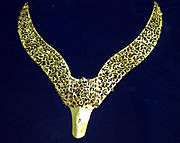 Gold ornament from early Silla
Gold ornament from early Silla A golden inner cap, 5-6th century Silla
A golden inner cap, 5-6th century Silla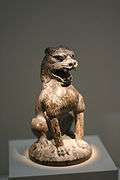 An artifact from Silla
An artifact from Silla Reliquary from 7th century Silla
Reliquary from 7th century Silla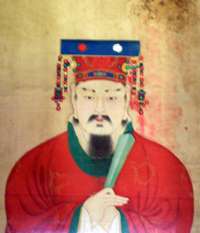 The last king of Silla, King Gyeongsun (r. 927–935)
The last king of Silla, King Gyeongsun (r. 927–935)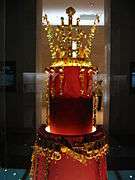 A crown from late 5th or early 6th Silla
A crown from late 5th or early 6th Silla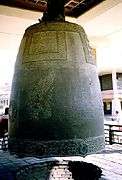 The Bell of King Seongdeok was cast in 771 AD.
The Bell of King Seongdeok was cast in 771 AD.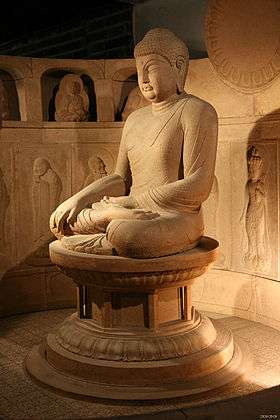
.jpg) This standing statue of the Bhaisajyaguru Buddha is made of gilt bronze, made in the Silla period.
This standing statue of the Bhaisajyaguru Buddha is made of gilt bronze, made in the Silla period.
See also
Notes
- 57 BC according to the Samguk Sagi; however Seth 2010 notes that "these dates are dutifully given in many textbooks and published materials in Korea today, but their basis is in myth; only Goguryeo may be traced back to a time period that is anywhere near its legendary founding."
References
Citations
- Lee 1984, pp. 83–84.
- 박용운 (1996). 고려시대 개경연구 147~156쪽.
- "...the first united Korean nation-state was established by the Silla Dynasty" The Two Koreas and the Great Powers, p. 48. Cambridge University Press.
- "Archived copy". Archived from the original on 2008-03-21. Retrieved 2008-03-08.CS1 maint: archived copy as title (link) Retrieved on 2008-03-08
-
History of the Northern Dynasties Volume 94, History of Silla Classical Chinese
- 新罗者,其先本辰韩种也。地在高丽东南,居汉时乐浪地。辰韩亦曰秦韩。相传言秦世亡人避役来适,马韩割其 东界居之,以秦人,故名之曰秦韩。其言语名物,有似中国人。....其文字、甲兵,同于中国。
- Silla is a descendant of the Jinhan confederacy. Its land is in the southeast of Goguryeo and it is an old land, (once held by) the Lelang Commandery of Han dynasty. It is called Jinhan or Qinhan. According to Xiangyun (相伝), its founders were fugitives who arrived to avoid hardship during the Qin dynasty. Mahan gave their eastern land to them and settled those Qin people there. Therefore, this is called Qinhan. Their language and name are similar to Chinese.

-
Samguk Sagi volume 1 Classical Chinese
- 前此 中國之人 苦秦亂東來者衆 多處馬韓東 與辰韓雜居 至是寖盛 故馬韓忌之 有責焉
- The location of Jinhan is east of Mahan. Traditionally, they are fugitives who came to Korea of old, to avoid hardships of the Qin dynasty. And Mahan said they gave them their eastern land.

-
Ri Zhi Lu Volume 29 Classical Chinese
- 辰韩亦曰秦韩,相传言秦世亡人避役来适,马韩割其东界居之。以秦人故,名之曰秦韩。其言语名物有似中国人。
- The location of Jinhan is east of Mahan. They are fugitives who came to Korea to avoid the hardship of the Qin dynasty. Mahan said they gave their eastern land to them. They set up castle fences and their language is similar to the one in Qin dynasty. It is also called Qinhan.

- Horesh, N. (2014). Asian Thought on China's Changing International Relations. Palgrave Macmillan. p. 175. ISBN 978-1137299321. "According to the Samguksagi entry for the 38th year of King Bak Hyeogeose of Silla, it is claimed that refugees from Qin settled in Jinhan, that is south-eastern Korea."
-
Samgungnyusa volume 1 Classical Chinese
- 後漢書云。辰韓耆老自言。秦之亡人來適韓國。而馬韓割東界地以與之。相呼為徒。有似秦語。故或名之為秦韓。
- The History of the Later Han Dynasty writes, "An old person from Chenhan State said that some refugees came to Korea from the Chinese Empire of Qin, and Mahan gave them some land of her eastern border.

-
Record of the Three Kingdoms Book of Wei, Volume 30, History of Jinhan Classical Chinese
- 辰韓在馬韓之東,其耆老傳世,自言古之亡人避秦役來適韓國,馬韓割其東界地與之。有城柵。其言語不與馬韓同,名國為邦,弓為弧,賊為寇,行酒為行觴。
- Jinhan confederacy is located in the east of Mahan confederacy. In the traditions of that area, the people of Jinhan were ancient fugitives who came to Korea to avoid the hardships of the Qin dynasty, and Mahan gave them their eastern land. They set up a castle fence and the language they speak is not the same as Mahan’s. There, they call “Guo” (Hanja: 国) (country) “Bang” (Hanja: 邦); “Gong” (Hanja: 弓) (arrow) “Hu” (Hanja: 弧); “Zei” (Hanja: 賊) (thief) “Kou” (Hanja: 寇); and “Xingjiu” (Hanja: 行酒) “Xingshang” (Hanja: 行觴).

-
Book of the Later Han Volume 85, History of Jinhan Classical Chinese
- 耆老自言秦之亡人,避苦役,適韓國,馬韓割東界地與之。其名國為邦,弓为弧,賊為寇,行酒為行觴,相呼為徒,有似秦語,故或名之為秦韓。
- The people of Jinhan are ancient fugitives who came to Korea to avoid the hardships of the Qin dynasty. Mahan said they gave their eastern land to them. In Jinhan, country is called “Bang (邦)”, arrow is called “Hu (弧)”, thief is called “Kou (寇)”, ”Xingjiu (行酒)” called as “Xingshang (行觴)” (turning cups of alcoholic drink) and they call each other “Tu (徒)”. Their language is similar to the language of Qin. So, this place is also called Qinhan.

-
Book of Jin Volume 97, History of Jinhan Classical Chinese
- 辰韓在馬韓之東,自言秦之亡人避役入韓,韓割東界以居之,立城柵,言語有類秦人,由是或謂之爲秦韓。
- The location of Jinhan is east of Mahan. They are fugitives who came to Korea to avoid the hardships of the Qin dynasty. Mahan said they gave their eastern land to them. They set up castle fences and their language is similar to the one in Qin dynasty. It is also called Qinhan.

- Cho Gab-je. 騎馬흉노국가 新羅 연구 趙甲濟(月刊朝鮮 편집장)의 심층취재 내 몸속을 흐르는 흉노의 피 (in Korean). Monthly Chosun. Retrieved 2016-09-25.
- 김운회 (2005-08-30). 김운회의 '대쥬신을 찾아서' <23> 금관의 나라, 신라. 프레시안. Retrieved 2016-09-25.
- 경주 사천왕사(寺) 사천왕상(四天王像) 왜 4개가 아니라 3개일까 (in Korean). 조선일보. 2009-02-27. Archived from the original on 2014-12-30. Retrieved 2016-09-25.
- 김창호, 〈문무왕릉비에 보이는 신라인의 조상인식 - 태조성한의 첨보 -〉, 《한국사연구》, 한국사연구회, 1986년
- "자료검색>상세_기사 | 국립중앙도서관". www.nl.go.kr. Retrieved 2019-04-15.
- 「제목=고구려와 흉노의 친연성에 관한 연구|저널=백산학보」『백산학보 제67호』
- 김대성. <이색보고> 金家 뿌리 탐사, 흉노왕의 후손 김일제 유적을 찾아서. 신동아. Retrieved 2016-09-25.
- 이종호『한국 7대 불가사의』、역사의아침、2007、p108
- 2부작 <문무왕릉비의 비밀> - 제1편: 신라 김씨왕족은 흉노(匈奴)의 후손인가?. KBS 역사추적. 2008-11-22. Retrieved 2016-09-25.
- 2부작 <문무왕비문의 비밀> - 제2편: 왜 흉노(匈奴)의 후예라고 밝혔나?. KBS 역사추적. 2008-11-29. Retrieved 2016-09-25.
- (채널돋보기) 신라 김씨 왕족은 흉노의 후손일까. 매일신문. 2008-11-21. Retrieved 2016-09-25.
- Encyclopedia of World History, Vol II, P371 Silla Dynasty, Edited by Marsha E. Ackermann, Michael J. Schroeder, Janice J. Terry, Jiu-Hwa Lo Upshur, Mark F. Whitters, ISBN 978-0-8160-6386-4
- "성골 [聖骨]". Empas Encyclopedia. Retrieved 2006-08-29.
- The Bone Ranks and Hwabaek
- "1,500 Years of Contact between Korea and the Middle East". Middle East Institute. Retrieved 2017-04-13.
- 매일신문
- '하회마을·양동마을 세계문화유산 추진
- Connor p. 268
- Park, Jin Y. article "Buddhism in Korea" in Keown and Prebish 2010 : 449.
- Buddhism of Silla "Archived copy". Archived from the original on 2008-03-21. Retrieved 2008-03-08.CS1 maint: archived copy as title (link)
- "Archived copy". Archived from the original on 2008-04-30. Retrieved 2008-03-08.CS1 maint: archived copy as title (link) Retrieved on 2008-03-08
- Birmingham Museum of Art (2010). Birmingham Museum of Art : guide to the collection. [Birmingham, Ala]: Birmingham Museum of Art. p. 34. ISBN 978-1-904832-77-5.
- "Cultural ties put Iran, S Korea closer than ever for cooperation". Tehran Times. 2016-05-05. Retrieved 2017-04-13.
Sources
- Connor, Mary E. (2009). The Koreas. ABC-CLIO, LLC.
- Keown, Damien; Prebish, Charles S., eds. (2010). Encyclopedia of Buddhism. New York: Routledge. ISBN 978-0-203-49875-0.
- Lee, Ki-baik (1984), A New History of Korea, translated by Wagner, Edward W.; Schultz, Edward J., Harvard University Press, ISBN 9780674615762
External links
| Wikimedia Commons has media related to Silla Kingdom. |